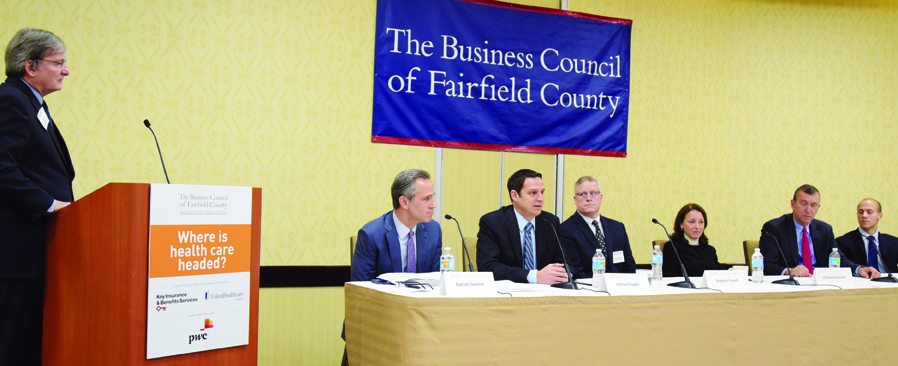The challenges and benefits of shifting away from volume-based care in favor of a value-based approach was the main topic at “Future Directions in Health Care,” a panel discussion featuring six senior executives from area hospitals and insurance companies held Feb. 2 at the Sheraton Stamford Hotel.
The event was held under the auspices of The Business Council of Fairfield County, whose vice president, Joseph McGee, serving as moderator, noted that the paradigm shift has had the added benefit of bringing health care providers and insurers more closely together.
 The move “started with Medicare”™s realization about the aging population, and that the trajectory of Medicare spending would become unaffordable,” said Patrick Charmel, president and CEO at Griffin Hospital, a private facility in Derby. Under the old model, hospitals were in effect being incentivized to “wait until the patient got sick ”“ and the sicker, the better,” he said.
The move “started with Medicare”™s realization about the aging population, and that the trajectory of Medicare spending would become unaffordable,” said Patrick Charmel, president and CEO at Griffin Hospital, a private facility in Derby. Under the old model, hospitals were in effect being incentivized to “wait until the patient got sick ”“ and the sicker, the better,” he said.
The result has been overtesting and overtreating, he remarked, with the added problem that roughly 30 percent of hospitalized patients return to the hospital within 30 days.
Charmel said the U.S. spends on average twice that of any other industrialized country on health care, a ratio that is 10 to 1 for patients over the age of 65. That situation should improve as the industry refocuses from a reactive position of treating the sick to a more proactive approach of keeping people well, he said.
“This is 100 percent the right way to incentivize us,” Norwalk Hospital President Michael Daglio said. Though moving away from an “every bed filled” system to “the right beds for the right patients” ideology will be cumbersome, Daglio expressed confidence that such a shift can be made, ultimately resulting in better quality care and healthier patients.
“We used to arm-wrestle over these issues,” said Stephen Farrell, CEO, UnitedHealthcare of New England Inc. “Now there”™s a lot of agreement.”
One of the main challenges to achieving greater consumer satisfaction comes with health care literacy, he said. “Patients who understand their health benefits, how to take care of themselves and how to deal with the way the system works” stand a better chance of achieving such satisfaction, he said.
As part of that effort, United provides a health care cost estimator, by which employers and patients can research the varying costs of a particular surgery or treatment, as well as ratings of physicians and facilities.
Mark Santos, president, New England market at Aetna, agreed, decrying the fact that, when people are involved in auto accidents, they routinely scout around for repair estimates; when it comes to surgery or other procedures, however, they tend to equate high cost with better care.
Vincent Petrini, senior vice president for public affairs at Bridgeport Hospital, touted the employment by Yale New Haven Health system, of which Bridgeport is a part, of Epic Systems, whose software is used to produce “MyChart,” a single electronic medical records that follows individuals everywhere, thus reducing redundancies whether that individual is visiting their usual care provider or going to an out-of-state emergency room. “Something like Epic helps lower costs and leads to a better patient experience,” he said.
The need for more transparency is critical, all agreed, though Jill Rubin Hummel, president, Anthem Blue Cross and Blue Shield, noted that “In some cases, transparency tools can increase costs.” Echoing Santos”™ comments, she said that, “In the absence of good quality data, people default to the higher price and blow through the max cost of a knee replacement.”
The panel took a fairly gloomy view when talk moved inevitably to the posited “replace and repeal” of the Affordable Care Act. Hummel wondered if the state”™s uninsured rate ”“ which stands at about 2 percent, down from 4 to 5 percent before ACA, or Obamacare, went into effect ”“ would stay that low, while Charmel and others expressed concern over the future of Medicare and Medicaid under the Trump administration.
Santos noted the health care industry”™s top priority is to have a plan in place, whatever shape it may take. “2018 is already done and set, or will be by (this) April,” he said of insurers”™ strategies. “Now we need to know about 2019.”




















